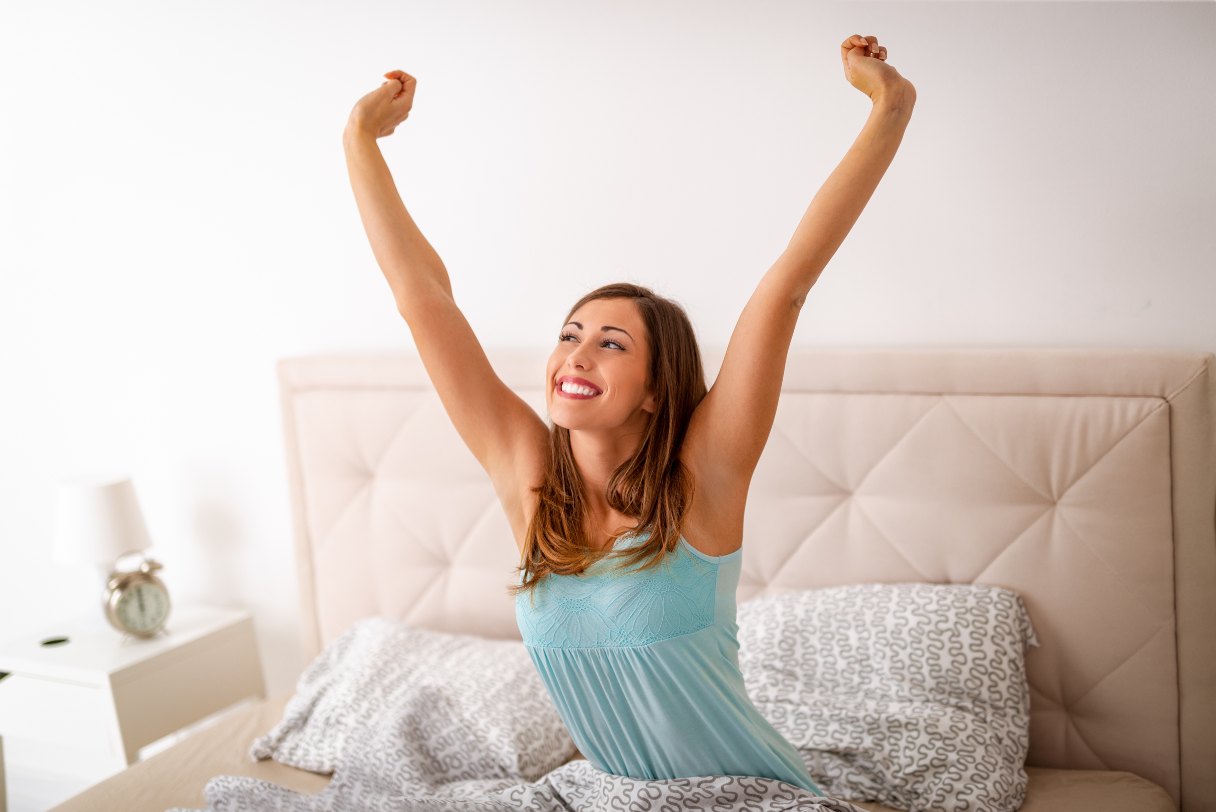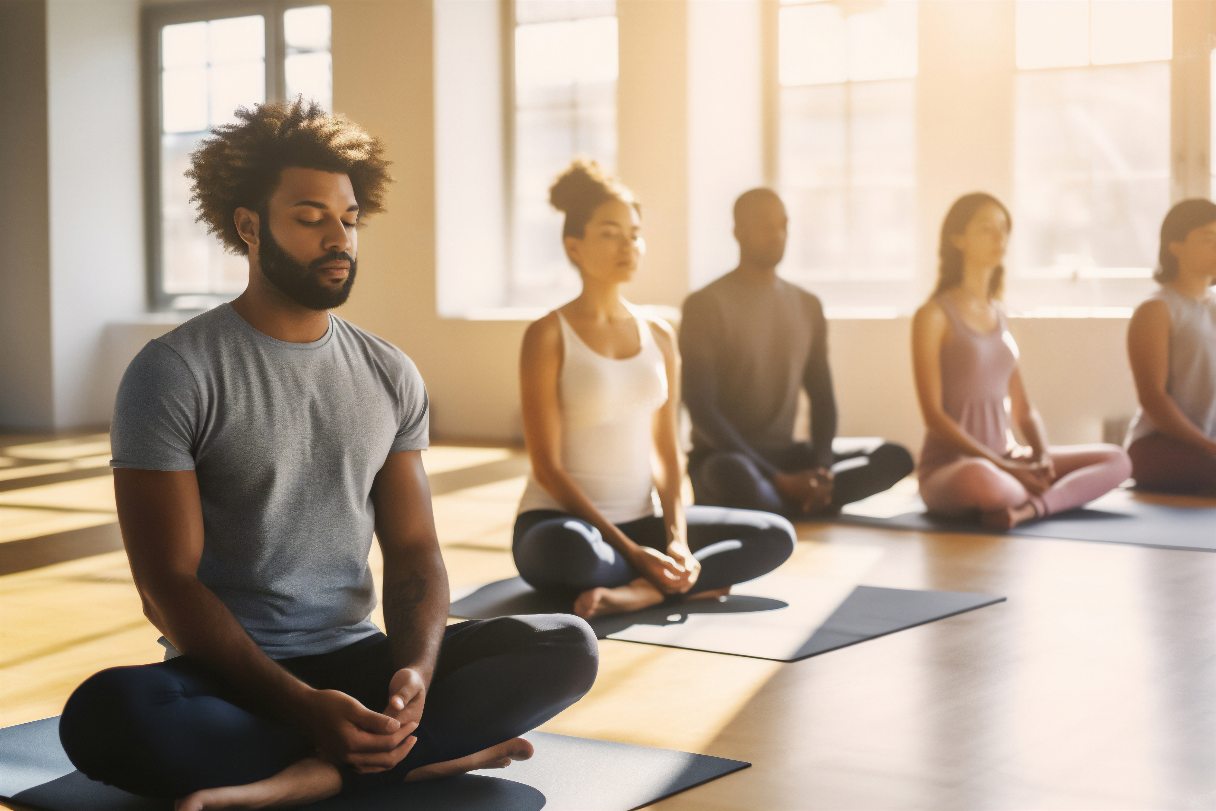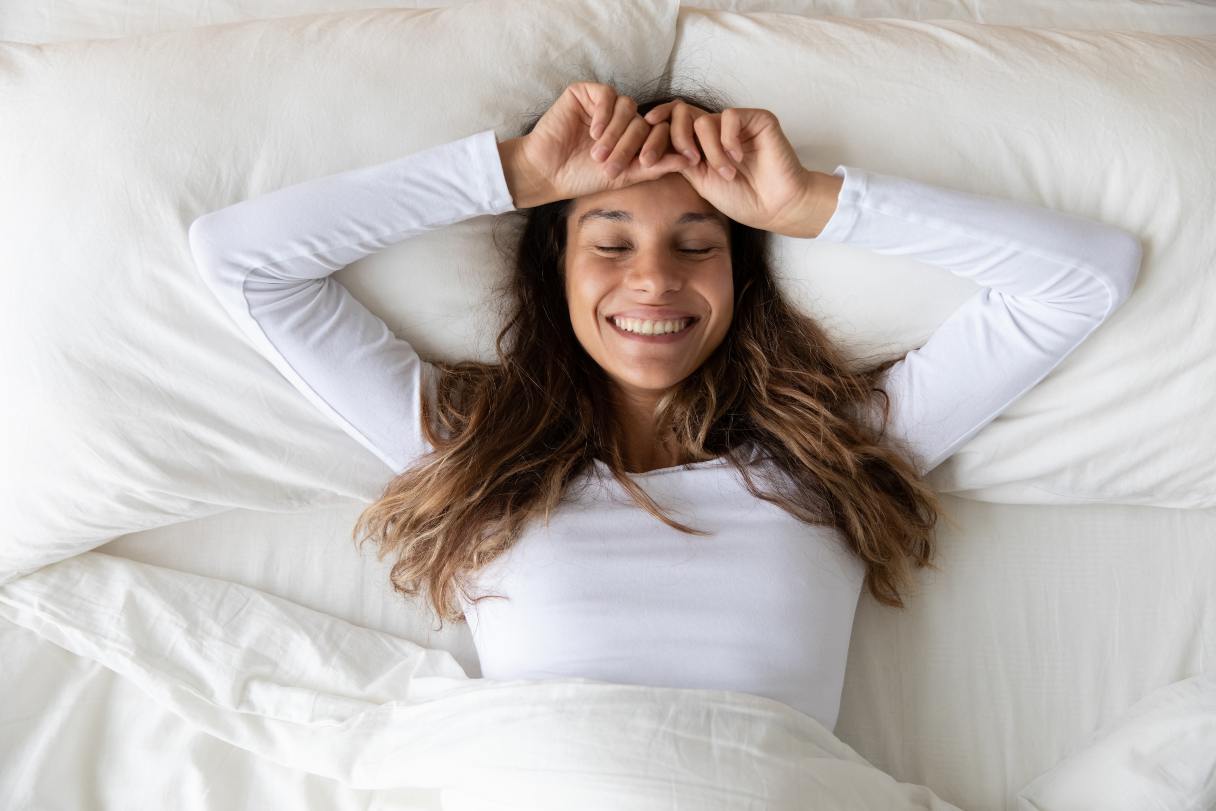Along with good nutrition and regular exercise, getting enough sleep is the third pillar in the trifecta of healthy habits for well-being. Adequate sleep for most adults is seven or more hours per night, but 1 in 3 adults say they're not getting enough.1
Sleep latency refers to the amount of time it takes to fall asleep, typically about 15 to 20 minutes for most adults. People who have an excessively long sleep latency period or tend toward insomnia often have difficulty shutting off worries or anxieties and sometimes exhibit signs of stress, such as an elevated temperature, faster heartbeat or tense muscles.2
Employing sleep techniques can help you reach the Land of Nod faster and often include elements of purposeful relaxation, such as deep breathing and focused attention, which signal to the body and mind that it's time to prepare for sleep.2
Let's look at some of the most popular techniques in more detail.
1. The Military Method
The military method is a deep relaxation technique designed to help soldiers fall asleep in two minutes under virtually any conditions. Try using the military method by following these steps:2
- Find a comfortable position, either lying down or sitting up, in a place where you can relax your body.
- Close your eyes and begin to inhale and exhale deeply and slowly. Starting with the top of your head, begin to relax each muscle, including the brow, eyes, cheeks, lips, tongue and jaw.
- Continue down the body, relaxing the muscles on one side, then the other. While still breathing deeply, relax your right shoulder, bicep, forearm and hand. Repeat on the left side.
- Relax your chest, shoulder blades, torso, hips and glutes.
- Relax your right thigh, knee, calf, ankle and foot. Repeat on the left.
- Clear your thoughts and try to think of nothing — which can be challenging. If intruding thoughts come up, acknowledge them and return your attention to your breath or visualize a soothing image.
- Repeat the steps as needed until you relax into sleep.
2. The 4-7-8 Method
The 4-7-8 method is based on controlling your breath to control your nervous system. Mindful breathing techniques like the 4-7-8 method have been shown to reduce stress and support relaxation.3
This breathing method can be done anywhere and at any time but takes some practice, as you may feel lightheaded at first. Begin practicing with four cycles, working your way up to eight. Here's how:3
- Find a comfortable place to sit or lie down with your back straight.
- Place your tongue against the back of your top teeth.
- Purse your lips and exhale completely through your mouth, keeping your tongue against your top teeth. Make a whoosh sound if it helps to expel more air.
- Close your lips and inhale through your nose for four counts.
- Hold your breath for seven counts.
- Exhale completely through your mouth for eight counts.
- Repeat for three more cycles.
3. Progressive Muscle Relaxation
This technique promotes relaxation and stress reduction by combining controlled breathing with muscle contraction and release of the major muscle groups. Here's how:2
- Lie down with your eyes closed and begin to inhale and exhale in slow, deep breaths.
- Tense your face muscles for a count of 10. Release the muscles and take three to four deep breaths.
- Move down the body, tensing and relaxing each muscle group while continuing to inhale and exhale deeply: Tense and relax your neck and shoulder muscles, back, torso, glutes, legs and feet.
4. Meditation
While guided meditation can be done anytime, practicing this technique before bed can be particularly helpful in calming the mind and releasing worries, tension and anxiety.2 You can practice sleep meditation using your own music or prompts, but some people find using a sleep app or other audio recording as a guide to be more effective.
A sleep meditation may include any or all of the following components:
- Body scan. This prompts you to notice feelings or sensations in your body without attempting to change them. For example, you might notice sensations of tingling, tightness or tension or emotions like sadness, worry or fear. You may be asked to relax each body part by breathing into that area.4
- Breathing exercises. Counting as you inhale and exhale can help slow down your nervous system and signal that it's time for sleep.5
- Gratitude practice. Shift your focus to what you're grateful for and show yourself loving kindness.
5. Guided Imagery
Guided imagery typically involves listening to a recording to help you visualize a calm memory or imagine a serene setting to prepare the body and mind for sleep.2
For example, you might be prompted to release worrying thoughts and stress with imagery of clouds floating in the sky or water moving in a river. You’ll likely be encouraged to take slow, deep breaths and focus on immersing yourself in the sensory details of your calming scene. (Guided imagery soundtracks are readily available online.)2
6. Keep a Consistent Sleep Schedule
Getting to bed and waking up around the same time — even on weekends — can help regulate your natural circadian rhythm, your body's internal clock that signals alternating periods of sleep and wakefulness. A consistent routine is one component of healthy sleep hygiene and can help improve sleep latency and quality.1
7. Limit Naps
Prevent disruptions to your natural sleep-wake cycle by limiting naps during the day. Napping too long or too late in the day can make it harder to fall asleep at night. If you’re having trouble sleeping at night, consider resisting a nap altogether, but if you do nap, keep it short, no longer than 20 minutes, ideally after lunch in the early afternoon.6
8. Create a Sleep Routine
Developing a consistent sleep routine can help your body and mind transition to a relaxed state and ease into sleep. You may need to experiment to find what works for your sleep routine, but there are several ways to signal that it’s time for sleep:
- Journal your thoughts. This is especially helpful if your mind tends to race with thoughts before bed. Writing down your worries or making a to-do list for the next day can help clear your mind and reduce anxiety.
- Sip herbal tea. Chamomile, lavender or valerian are known for their calming properties that can help ease you into sleep.4
- Take a warm shower or bath. This simple activity can relax your muscles and calm your mind. A shower or bath can also slightly lower your body temperature afterward, signaling to your body that it’s time to sleep.1
- Practice gentle yoga. Incorporating slow, mindful stretches can relieve physical tension, reduce stress and promote relaxation, preparing your mind and body for a restful sleep.4
- Listen to music. A relaxing playlist of your favorite mellow tunes can create a sense of comfort and peace that helps you drift off more easily.2
- Read a book. Opt for a hardcover or paperback to avoid the blue light emissions from a smartphone or tablet.1
9. Move Your Body (During the Day)
Thirty minutes of moderate daily exercise is recommended for most adults, as getting enough exercise during the day can help you fall asleep faster at night.1 However, be aware that for some people, a vigorous workout close to bedtime may be stimulating, making it harder to fall asleep.5
10. Aromatherapy
Aromatherapy, or using essential oils and other aromatic plant compounds, has been employed for many years to promote health and well-being, including relaxation and stress relief. Essential oils like lavender, cedarwood and clary sage are popular choices to promote sleep and can be used with an essential oil diffuser or formulated for topical use on your skin.7
11. Limit Screen Time
While you've likely heard it before, it's worth repeating: Our electronic devices are not helping us sleep at night. Phones, tablets, TVs, computer screens and gaming devices emit blue light, which is thought to interfere with our circadian rhythms.1 Try going screen-free for at least one to two hours before going to sleep.6 If you must look at a device before bedtime, adjust the settings to night mode, which typically shades the screen in an amber light that's less disruptive to your natural sleep signals.
12. Avoid Caffeine and Alcohol
It's best to avoid caffeine for at least four to six hours before bedtime, as this stimulant takes three to five hours to leave the body.4 Some people find that reducing caffeine intake during the day greatly improves their ability to fall asleep at night.
And while alcohol may help you relax and fall asleep quickly, it tends to disrupt the sleep cycle, resulting in poor-quality sleep or wakefulness during the night.6 Experts recommend avoiding alcohol for a minimum of four hours before bedtime.4
13. Relaxing Activities
Tossing, turning and worrying about not sleeping can be counterproductive. Instead, get out of bed and try a soothing, distracting activity like reading, journaling your thoughts, light yoga stretches or relaxing with an adult coloring book. Avoid screens or other stimulating devices. Do the activity until you feel drowsy, then get back into bed. Repeat as needed until you drift off to sleep.1
14. Sleep Supplements
Some supplements may help you fall asleep faster. These might include melatonin and magnesium.
Melatonin is a hormone in the body that helps regulate sleep. It is available in pill, patch or liquid form, and when taken as a supplement, can assist with issues like jet lag and other sleep disruptions.8
While typically considered safe for short-term daily use in adults, it's important to consider factors such as:8
- Age
- Overall health
- Specific sleep concerns
- Potential interactions with prescription medications, like those for epilepsy, diabetes, high blood pressure, blood thinners or birth control
Magnesium is an essential mineral that plays a role in multiple body functions, including muscle and nerve performance, bone development, blood sugar regulation and heart rate regulation. Some research suggests magnesium may also improve sleep quality by helping to regulate the neurotransmitters that calm the nervous systems and support melatonin production.9
Taking a magnesium supplement, particularly before bedtime, can:9
- Ease muscle tension
- Reduce stress
- Potentially help you fall asleep faster
The amount of magnesium to take depends on your lifestyle, age and health. Generally, most healthcare professionals recommend taking no more than 350 milligrams of magnesium supplements per day to avoid side effects like diarrhea, nausea or abdominal cramps.9
It's a good idea to consult your physician first on whether or not melatonin, magnesium or any supplement is a good choice to help with the situational sleep issues you may be having.
15. Snuggle With Your Pet
There was a time when most healthcare professionals typically advised against sleeping with a furry friend, but more recent research seems to suggest that co-sleeping with a pet may have positive effects on mental and emotional health.10
Sleeping with pets can provide comfort, security and stress relief, contributing to a better night’s sleep. The presence of a beloved pet can help reduce anxiety and lower cortisol levels, creating a calming environment conducive to rest.10
Many people find their pet’s rhythmic breathing or gentle warmth soothing, which can promote relaxation and help them fall asleep faster. However, safety is paramount. If your pet triggers allergies, is territorial about their sleeping area or their movements are likely to cause sleep disruptions, you may want to think twice before you offer your pet a spot on your bed.10
It’s essential to ensure your pet’s sleeping habits align with yours so everyone gets a restful night's sleep.
16. Optimize Your Sleep Environment
Create an optimal sleep environment by adjusting your bedroom to make it more conducive to quality sleep. Here are a few suggestions:
- Check the thermostat. Between 60 and 67 degrees Fahrenheit is recommended for a comfortable sleeping environment.1
- Turn the clock around. Watching the minutes go by won’t help you get to sleep faster. Place your clock so that you can’t see the time.5
- Keep the room dark. Light-blocking curtains, doors or a sleep mask can help minimize light from the street, other rooms or the displays from electronic devices.1
- Minimize disruptions. Make the room as quiet as possible. Try a fan, low music or a sound machine to block out extraneous noise from phones, pets and other sounds.5
17. Ensure You Have Good Mattress Support
A mattress that is too soft, too hard or simply uncomfortable won’t support healthy sleep. Invest in a mattress that suits your needs, particularly if you experience limited mobility, chronic pain or sleep apnea. An adjustable mattress may provide the comfort and support you need.6
When to Seek Help
Many people can improve their sleep hygiene and fall asleep faster by making small changes to their sleep routine. However, if you consistently have trouble falling asleep or regularly experience poor-quality sleep that affects your waking hours, consulting with a healthcare professional or sleep specialist may be beneficial. They can help identify any underlying sleep disorders or medical issues and recommend a treatment plan to support better, high-quality sleep.6
Managing Health and Wellness Costs With the CareCredit Credit Card
If you are looking for an option to help manage your health and wellness costs, consider financing with the CareCredit credit card. The CareCredit credit card can help you pay for the care you want and need and make payments easy to manage.* Use our Acceptance Locator to find a provider near you that accepts CareCredit. Continue your wellness journey by downloading the CareCredit Mobile App to manage your account, find a provider on the go and easily access the Well U blog for more great articles, podcasts and videos.
Your CareCredit credit card can be used in so many ways within the CareCredit network including vision, dentistry, cosmetic, pet care, hearing, health systems, dermatology, pharmacy purchases and spa treatments. How will you invest in your health and wellness next?
Author Bio
Anne-Marie Kennedy is a freelance writer with more than 20 years of experience covering health and wellness, personal finance and real estate/investing.







